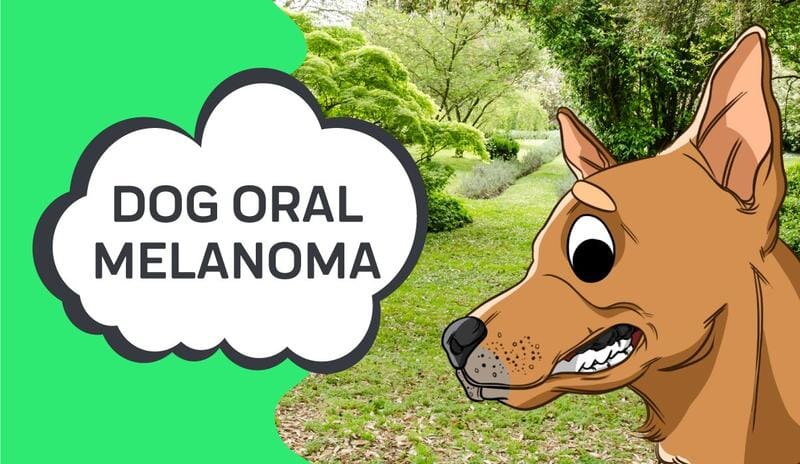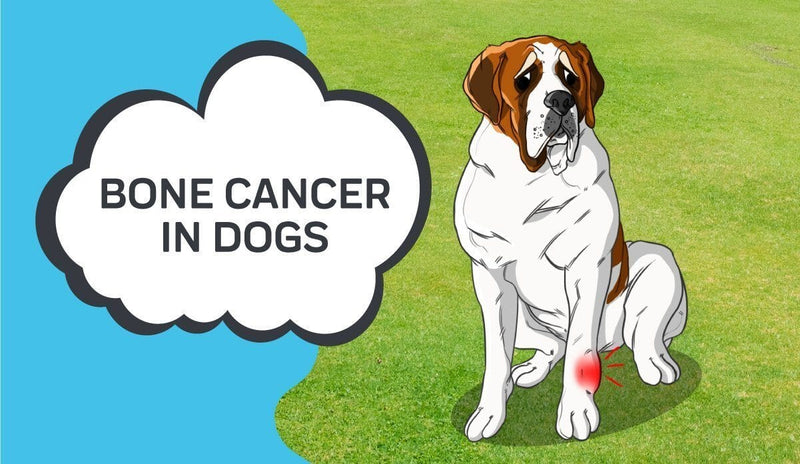- What is Oral Melanoma in Dogs?
- Is oral cancer in dogs painful?
- Symptoms and Side Effects
- How to Treat Oral Tumors in Dogs
- Is There a Canine Melanoma Vaccine for Oral Cavities of Dogs?
- Survival Rates in Dogs with Canine Oral Melanoma
- The Bottom Line
Oral melanoma is one of the many kinds of cancer that canine can contract at any given point in their lives. Sometimes, it arises by chance. Other times, cutaneous melanoma (cancer that starts in skin cells that produce pigment) stems from overexposure to radiation.
It’s important to understand what oral melanoma is, how to identify it, and ways to treat cancer. A diagnosis is scary, but learning about cancer is better than staying in the dark and fearing the unknown. Without further ado, let’s learn about oral melanoma.
What is Oral Melanoma in Dogs?
As a pet owner, the number one goal in raising our canines is to keep them as healthy as possible for as long as possible. There are so many preventative measures that we can take to improve our pet's quality of life, but sometimes, no matter how proactive you are, nature takes its course and inflicts an illness that seems to come out of nowhere.
One of the most detrimental diseases that canines face is cancer. Malignant melanomas, or skin cancers, are a very common type of cancer in dogs. Today, we're going to be talking about a type of canine cancer known as oral cutaneous melanoma. As you can guess, this is a form of skin cancer within the mouth. These tumors mostly develop from a melanoma squamous cell carcinoma.
Denoted most obviously by oral tumors in dogs, canine oral melanoma is the type of cancerous primary tumor cells that impact the highest percentage of canines. In fact, not only are all canines more likely to get oral melanoma than some other forms of cancer, but male canines are at an even higher risk of encountering the disease at some point in their lives.
Cancerous tumors and oral melanoma are more likely to occur in older canines. For male canines, the typical age at which they are diagnosed is around eleven years of age.
It’s very uncommon for puppies and middle-aged canines to have melanoma of the oral cavity, though it’s still important to be aware of the symptoms of the condition just in case. Speaking of oral melanoma symptoms in canines, what are some of the signs that your dog might have this disease? We’ll discuss that below.
Is oral cancer in dogs painful?
Whether or not oral cancer in dogs is painful depends on the severity of their condition. Dogs with just a tumor might be experiencing pain, whereas those who have already undergone surgery to remove the cancerous cells will likely feel fine as long as they are otherwise healthy and able-bodied for their size.
Symptoms and Side Effects

One of the most visible signs of this condition is weight loss. But before the weight loss is obvious, canines will lose their appetite and eat very rarely, if ever, which of course leads to losing weight over time.
Since this cancer is located within the mouth of your dog, it naturally affects your dog's appetite, hunger, and willingness to eat despite those two variables. Oral melanoma can be painful, which makes eating a lot less appetizing... Literally.
Other side effects that can appear include...
- Swelling of the facial features
- Inflammation of the gums
- Odd-smelling breath and smells coming from your dog's mouth
- Signs of pain and discomfort
- Drooling or increase in saliva production
- Difficulty using facial muscles
- Hard time swallowing or drinking water
How to Treat Oral Tumors in Dogs
There are four main treatment options, including…
- Surgical excision
- Chemotherapy
- Radiation therapy
- Non-steroidal anti-inflammatory drugs
Surgical Removal of Oral Melanoma Cancer Cells
The number one treatment option for canines with oral melanomas is the surgical removal of the tumors. Surgically removing a tumor eliminates the source of the problem. Sometimes, surgery is only half the battle, though.
This is especially true in situations where a dog's cancer has already metastasized because it means the cancerous cells have traveled to other body parts. Sadly, oral melanoma is always a metastatic disease, meaning that it quickly spreads to create new tumors throughout the body, especially if it reaches the lymph nodes and lungs.
Canine cancer specialists will likely perform a CT scan to figure out the precise location of your dog’s oral tumor. The CT scan will also help the specialists understand if there is only one concerning lump or multiple malignant tumors.
Removing the cancerous cells is helpful but it doesn't eradicate all of the cancer because it is a metastatic disease - at this point, it has already moved to other parts of the body by way of the local lymph nodes. When cancer metastasizes, it often invades surrounding local lymph nodes, which then naturally move to other internal systems and organs, spreading the cancerous cells as they go.
When surgical removal of the tumor cells does not reach the goal of remission, specialists can choose to order chemotherapy treatment if they think this will increase the dog’s chance of survival. Chemotherapy is a very intense process that utilizes incredibly aggressive drugs to kill the cancer cells.
Chemotherapy as an option for Treatment of oral tumors in Dogs
Chemotherapy always makes canines feel sick to their stomachs, and it wipes out their entire energy reserves as well. They may even appear sicker than before they began the treatment, but try to remember that the vet believes this will eventually cure your pet of their disease.
More often than not, chemotherapy is an impressively effective treatment option for canines with oral tumors, especially when combined with radiation therapy. Even though it causes a plethora of adverse side effects, chemotherapy can be hugely beneficial in treating cancer. Canines with stage three and stage four melanoma are almost always treated with chemotherapy unless the dog cannot physically handle the intensity of the medications. At that point, it is decided that putting the dog through the pain is not worth it, as they’re unlikely to benefit from it.
Oral Tumor Radiation Therapy
Despite its intensity, sometimes chemotherapy alone isn’t enough to keep the cancerous cells from returning. That’s where radiation therapy comes into the picture. Radiation therapy uses actual radiation to target any remaining cancer cells, all while minimizing the destruction of normal and healthy cells in your dog’s body.
As part of radiation therapy, your dog might receive an abdominal ultrasound, particularly if the vet is concerned that the cancer has metastasized. The point of an abdominal ultrasound is to see if the cancer cells have moved to other parts of the body.
Non-Steroidal Anti-Inflammatory Drugs for Dogs
Even though radiation is usually a secondary treatment option, in scenarios where the cancer is not as severe, radiation might be implemented alongside non-steroidal anti-inflammatory drugs as the sole form of cancer treatment in canines.
Also known as NSAIDs, non-steroidal anti-inflammatory medications are made up of prostaglandins-blocking compounds. Prostaglandins are chemicals that cause a lot of inflammation in your dog's body as a response to physical trauma and injuries. As painful as the inflammation is, it's equally as important because it also offers positive benefits, including the blood's ability to clot and the stomach's ability to protect itself from natural-forming acid. But the enzymes that produce prostaglandins are activated by cancer, as well as the cancer treatment of chemotherapy.
Together, they are powerful and capable of helping dogs with non-cancer functions, but in terms of cancer, prostaglandins and the related enzymes can worsen symptoms dogs with oral tumor melanoma are experiencing. As helpful as prostaglandins can be in certain ways, they cause a lot of inflammation, and this is detrimental for dogs with melanoma of the oral cavity.
So, introducing NSAIDs, which are prostaglandin-blocking medications, will reduce the bodily and facial swelling drastically. Prostaglandins are also well known for their contribution to fevers and internal pain, which sometimes goes so far as to manifest as physical discomfort as well.
Is There a Canine Melanoma Vaccine for Oral Cavities of Dogs?
Surprisingly, there is a vaccine for this disease. Now, you may be wondering how this is possible, especially given the fact that vaccines are intended to prevent dogs from catching a virus, and cancer is not a virus. This is true, but there's a small detail about canine oral melanoma that makes this type of cancer suitable for vaccination.
Oral melanoma is caused by an immunogenic tumor, which can be resolved with the right vaccine. This melanoma vaccine has been shown to increase the average survival times of dogs with stage II, III, and IV oral melanomas.
However, the vaccine is not the same as, say, the seasonal influenza vaccine that humans receive each year. In other words, the melanoma vaccine is not preventative. Instead, the melanoma vaccine is only used in cases where a dog already has metastatic disease.
Survival Rates in Dogs with Canine Oral Melanoma
How Long Can dogs live with mouth cancer?
There are four main stages of oral cancer for dogs, and as the stages increase in severity, the survival chances decrease. This is the prime example of all prime examples that support early detection as the best treatment option for dogs.
Here's a glimpse into what the median survival times are for each of the four stages.
Stage One
Stage one is the least severe stage of oral melanoma, but it still demands immediate attention. Cancer that is caught in the first stage often entails longer survival times, with most dogs living for approximately one year after treatment. At this stage, all treatment options can be used, from radiation therapy to surgery.
Stage Two
Dogs with oral carcinoma categorized as a stage two diagnosis are looking at a prognosis of roughly six months. Some dogs will live a little longer, but the median survival time of dogs with stage II oral melanoma is six months at the most.
Stage Three
Dogs with stage III oral melanomas are given a predicted survival time of three months. Treatment options are often more intense at stage three given the aggressive nature of oral melanoma in the third stage.
Stage Four
Stage IV is considered crisis mode. The chances of dogs living for very long once stage four oral melanomas is discovered run very slim. By this stage, the primary tumor has certainly metastasized. The approximate survival time of dogs with stage four cancer is about one month, but bear in mind that this is approximate and will vary. Not all dogs will pass away within a month of receiving a diagnosis.
Can dogs survive oral cancer?
Oral cancer is a very serious condition that can affect any dog. The average lifespan of an affected canine ranges from 4-6 months, but with treatment (chemotherapy and/or radiation) the survival rate increases to about 2 years!
The Bottom Line
Oral melanomas are a scary prospect for dog owners, especially as it’s transferable - if you have two pups and one becomes ill, you’re right to be worried that the other might become ill too. That’s why it’s important to know about the signs and symptoms of this disease so you can immediately be seen by a vet if you suspect your dog could have the condition.
Sources:
Cutaneous MelanomaNonsteroidal Anti-inflammatory Drugs (NSAIDs)
Is Cancer in Dogs Contagious?
Melanoma
What Is Melanoma Skin Cancer?
Canine Oral Melanoma
Oral Tumors in Dogs - Melanomas
How We Treat Oral Melanoma in Dogs

Thanks for stopping by!
P.S. We Love You!
Sincerely,
The Innovet Team
Please do not ask for emergency or specific medical questions about your pets in the comments. Innovet Pet Products is unable to provide you with specific medical advice or counseling. A detailed physical exam, patient history, and an established veterinarian are required to provide specific medical advice. If you are worried that your pet requires emergency attention or if you have specific medical questions related to your pet’s current or chronic health conditions, please contact or visit your local/preferred veterinarian, an animal-specific poison control hotline, or your local emergency veterinary care center.
Please share your experiences and stories, your opinions and feedback about this blog, or what you've learned that you'd like to share with others.















